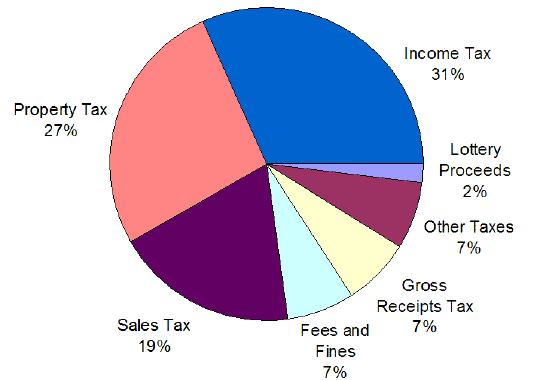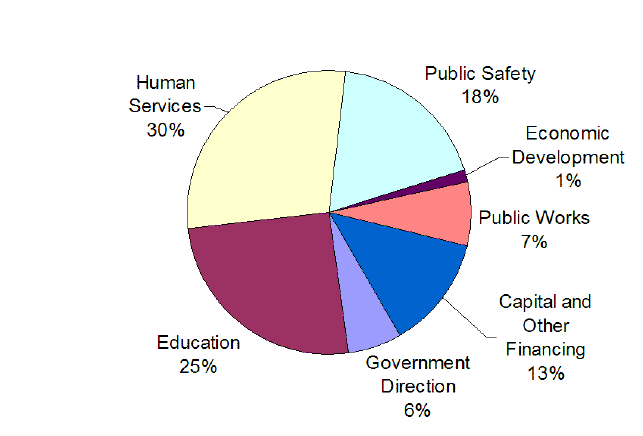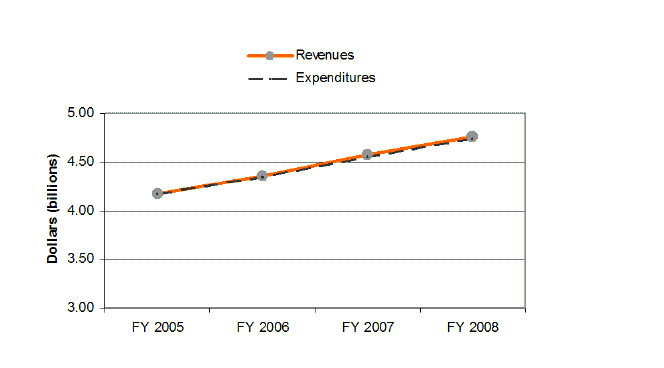

Back to Mayor’s Office main page
|
Columns DCWatch
Archives Elections Government and People Budget issues Organizations |
Mayor Williams Introduces FY 2005 Budget and Financial Plan(Washington, DC) Mayor Anthony A. Williams released his proposed FY 2005 budget during a press conference today. Mayor Williams outlined a plan providing for a balanced budget that allows for funding of a number of initiatives citizens identified as priorities at the Citizen Summit last November and during subsequent Neighborhood Citizen Summits. The proposed budget calls for $6.25 billion in total spending and $4.2 billion in local expenditures (8.9 percent funding increase over FY '04). The growth of funding in the budget is focused on improving critical services in the areas of education, public safety, health care and housing. "I am grateful for the input I've received over the past year from our citizens who took the time to articulate their priorities at meetings across the city," said Mayor Williams. "This budget makes critical investments to improve services in the areas most important to the citizens of Washington, DC. At the same time, the FY 2005 budget is balanced in a fair and responsible manner." At the Citizen Summit, citizens placed high priority on the quality of education in the District. The Mayor's proposed budget for FY 2005 includes an additional $22 million for DC public schools, $52 million for public charter schools and $173 million in capital funding for school facilities. This and other new funding will provide for school improvements such as the creation of a universal pre-kindergarten incentive program, expansion of local support for out-of-school activities, the creation of five new transformation schools, the creation of eight new public charter schools and an upgrade of school security. Residents also identified public safety as a major priority. The proposed budget includes $6 million in new funding to continue the deployment of 200 new police officers, $3 million in operating costs for a new youth services center and $800,000 in new funding to support an expansion of anti-violence initiatives for young people. Details of Mayor Williams' proposed budget for FY 2005 will be online later this week at www.dc.gov. GOVERNMENT OF THE DISTRICT OF COLUMBIA Executive Office of the Mayor Testimony of Anthony A. Williams, Mayor March 29, 2004 Good morning Chairman Cropp and members of the Council. I am pleased to be here today to discuss the proposed FY 2005 Budget and Financial Plan. Over the past year our citizens have articulated their priorities in citizen summits and town hall meetings across the city, and this budget is the manifestation of those discussions. Our residents are calling for better education, public safety, health care and housing, and this budget makes critical investments to improve services in these areas. As we invest in improved services, however, we must also maintain a high standard of fiscal responsibility. In the current economy, cities and states across the nation continue facing difficult financial circumstances. The District faces an even greater challenge in that our service needs greatly exceed our revenue capacity due to unfair restrictions imposed by the federal government. To face this challenge successfully we must achieve a high standard of strategic focus, resourcefulness, and discipline in our budget decisions. I believe this budget meets that standard, in part due to the valuable input of the Council. During the past two weeks, my administration has worked closely with committee chairs and other members to glean their insights on policy directions, efficiencies, and overall agency operations. I hope we can sustain this level of dialogue throughout the budget process. The proposed FY 2005 budget supports $6.25 billion in total funding and supports 34,050 full-time equivalent (FTE) staff. In local funds, this budget proposes $4.2 billion in funding and supports 26,050 FTEs. This local budget change represents an 8.9 percent funding increase over the FY 2004 approved budget and a decrease of 195 FTEs. The growth of funding in this budget is focused on improving critical services, perhaps the most important of which is public education. EducationAt our recent Citizen Summit III, where residents from across the District joined together to articulate their priorities, education quality emerged as a top priority. Specifically, residents placed high priority on enhancing the following:
In my State of the District Address I laid out a plan for an education renaissance to achieve improvements in these areas. To begin implementing that plan, my proposed budget includes an additional $22 million for DC Public Schools and $52 million for Public Charter Schools. This and other new funding will provide for a host of school improvements, including the following:
These service enhancements for school-age children will be supplemented by efforts to improve adult education. Having built a new set of adult literacy centers in recent years, the District will now focus its efforts on strengthening the collaboration between libraries, employment services, and the University of the District of Columbia to enhance the quality of our current adult literacy offerings. Through these initiatives the FY 2005 budget will support significant improvements in our residents' top education priorities. Beyond these efforts, however, there remains a level of reform needed that no amount of funding can achieve. Specifically, the current school governance structure creates fractured accountability for education where the School Board sets policy, the Mayor and Council control funding, and the Superintendent is hamstrung with conflicting direction and decentralized authority. To bring more streamlined and effective management to the school system, a superintendent must be empowered and supported to implement large scale reform. This empowerment can only be achieved, I believe, through a change in the governance system. My proposed change will call for the superintendent to report to the Mayor, with stronger Council oversight. It also changes the current school board role to one of policymaking rather than management oversight. Only through these changes do I believe that a large number of District school children will see improvements in their education. Several weeks ago I proposed the Omnibus Board of Education and DC Public Schools Restructuring Act of 2004 to bring this change about. I now renew my request that the Council enact this legislation. Public SafetyIn addition to education, residents consistently identify public safety as a major priority. Specifically, attendees at the most recent citizen summit identified greater police presence and juvenile justice as top priorities for service improvement. To achieve these improvements, the proposed budget includes the following initiatives:
Health CareIn the area of health care the FY 2005 budget continues expanding health care services for the uninsured, which citizens consider a major priority. Specifically the proposed budget includes funding to achieve the following:
A recent national study showed that that the percentage of residents without health insurance in D.C. is significantly lower than the national average. Through the budget enhancements presented above, the District can continue reducing the percentage of uninsured residents. Affordable HousingAffordable housing also ranks high among the top priorities of District residents. Recently the Council and I established a very promising tool for producing more affordable housing: the Housing Production Trust Fund. Under current law this fund is slated to receive 15 percent of deed recordation and transfer tax proceeds for the District. While this funding mechanism may produce significant resources over time, there is a need to provide more robust funding on a more immediate time frame in order to aggressively produce a large volume of affordable housing. To address this challenge my budget proposes securitizing the revenues earmarked for the Housing Production Trust Fund. Specifically this measure will yield $250-275 million for the fund in FY 2005, which could then be used to leverage many hundreds of millions of dollars in additional private development funds. The District then will use a 20- to 25-year stream of revenues at $20 million per year to retire the securitization bonds. This proposal improves the current funding mechanism by:
This proposal not only satisfies many competing concerns, but it also capitalizes on timing. Interest rates are at a very low level right now, thereby allowing for a maximum yield on this securitization. The District faces a great opportunity that should not be missed. Job TrainingThe final area of great citizen emphasis in recent dialogues is the availability of job training opportunities. This budget supports job training in the following ways:
Through these initiatives the District will enhance job training opportunities through both general and targeted means. These initiatives, coupled with other service improvements across the District, will help improve services for residents across the District. As we pursue these enhancements, however, we must ensure that the cost of government is funded in a balanced, fair, and responsible way. The following discussion presents the funding approach that supports this budget. Preserving Fiscal BalanceOver recent years there have been concerns raised that the growth of spending in the District budget cannot be supported by our local revenues. I not only share this concern, I have been among the most vocal in trying to address it. Due to unfair restrictions imposed by the federal government, the District must provide the same services as a city, county, and state, but cannot collect revenues as those other jurisdictions do. Moreover, our population has much greater service needs than those of other states, making the imbalance between revenues and expenditures even greater. These service needs - and their corresponding cost growth - are found in three specific areas: human services, education, and public safety. As documented by the U.S. General Accounting Office (GAO), the District has especially high numbers of young people, poor people, and people living in densely populated areas. These three factors are the major drivers for high-cost service needs in the areas of human services, education, and public safety. The District's budget growth reflects these changes. From FY 2004 to FY 2005 the areas seeing the greatest budget growth are human services ($123 million) and public education ($85 million). Public Safety also experienced large growth as well ($49 million). Together these three areas account for almost 75 percent of new expenditures. Likewise, these areas have received the highest dollar increases during the past 6 years. Despite the pressure to fund these services, however, the District must balance its budget each year, and we do. Some may say that our continual balance proves that the structural imbalance does not exist, but the truth is that we manage to balance each budget only by making major sacrifices in other service needs, and by asking our citizens to continue shouldering one of the highest tax burdens in the nation. This year is no exception. After estimating costs to meet critical service needs, early projections showed expenditures exceeding revenues by $306 million. To resolve a potential budget gap of that size, a budget proposal must be fair and responsible. On one hand the budget cannot be balanced through service reductions alone because a gap of that size would require draconian cuts. On the other hand, we cannot overburden taxpayers, particularly given the District's current tax structure. The best solution, I believe, combines a balance of spending reductions and revenue increases, and targets each of those in a direction that minimizes adverse impacts on residents, businesses, and the long-term economic growth of the District. I believe my proposed FY 2005 budget provides such a solution: Approximately half of the potential gap is closed through spending reductions, and the other half is closed through new revenues. Specifically, the expenditure reductions consist of the following:
To close the remaining gap the following revenue enhancements are proposed.
In addition to these initiatives, the multi-year financial plan demonstrates that the budget will not be balanced if the implementation of new tax cuts takes place in FY 2006 or FY 2007, as previously anticipated by recent revenue estimates. Therefore my budget proposal postpones the implementation schedule for Tax Parity to resume in FY 2008, which is the first year in which financial projections indicate that this implementation may be possible. Through the expenditure reductions and revenue enhancements presented above, the FY 2005 Budget and Financial Plan is not only balanced, it is balanced in a fair and responsible manner. In closing, I thank you and the Council for your consultation in the development of this proposal, and I look forward to our continued cooperation in finalizing and executing this package. GOVERNMENT OF THE DISTRICT OF COLUMBIA Improving
Critical Service
|
| FY 2004 Approved | FY 2005 Proposed | Percent Change | |
| Revenues | |||
| Local | 3.8 | 4.2 | 9% |
| Federal | 1.6 | 1.8 | 7% |
| Other | 0.2 | 0.3 | 27% |
| TOTAL | 5.7 | 6.2 | 9% |
| Expenditures | |||
| Local | 3.8 | 4.2 | 9% |
| Federal | 1.6 | 1.8 | 7% |
| Other | 0.2 | 0.3 | 27% |
| TOTAL | 5.7 | 6.2 | 9% |
Revenue capacity is constrained by federal restrictions on large portions of the DC tax base:

D.C. population is far younger, poorer, and more concentrated than the average U.S. state, which means far greater service demands in:

| Local budget reductions in agencies | $62 million |
| Expenditure transfers to non-local funds | $28 million |
| Deferral of duplicative spending through the Tobacco Trust Fund | $59 million |
| Deferred reserve contributions | $8 million |
| Total Budget Reductions | $157 million |
| Fund balance use | $54 million |
| Increased penalties and fines | $19 million |
| Closing of corporate tax loopholes | $3 million |
| Health care provider tax | $18 milion |
| Recovering deed/recordation transfer taxes | $20 million |
| Other miscellaneous fee and tax adjustments | $35 million |
| Total Revenue Enhancements | $149 million |

![]()
Send mail with questions or comments to webmaster@dcwatch.com
Web site copyright ©DCWatch (ISSN 1546-4296)